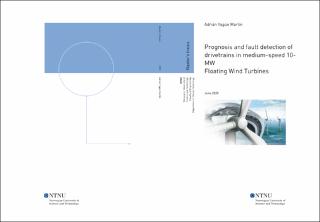| dc.description.abstract | Premature failures in large offshore Wind Turbines are often attributed to bearing failure despite gearboxes
being designed and developed using the best bearing design practices. Furthermore, as turbine size and
rated power increase, bearings display an enhanced tendency to fail. Unscheduled bearing replacement at
sea is a complex, costly, weather-dependent and time-consuming operation that results in high turbine
downtimes. Market trends show an increase in turbine rated capacity and a noticeable shift towards deeper
waters and far-off remote sites which further delays and complicates unscheduled maintenance activities
and aggravates the cost penalties of idle turbines. Detecting an incipient bearing fault (diagnosis task) is
therefore a major aspect to evaluate drivetrain and overall wind turbine reliability. Moreover, estimating the
remaining useful life of bearings and predicting their operational state in the future (prognosis task) can
achieve a breakthrough in optimizing maintenance programs, improve wind farm operation and decrease
wind turbine downtime which can bring about a significant cost reduction.
The purpose of this work is to investigate the health monitoring and prognostics possibilities of drivetrain
bearings in a floating spar-buoy offshore wind turbine. The drivetrain concept considered in this work is
based on DTU's 10-MW reference wind turbine. Specifically, this study targets the prognosis of four critical
drivetrain bearings located in the main shaft and the high-speed shaft. The absence of run-to-failure data
of real wind farms, although inconvenient, is overcome by using model-generated degradation data. A high-fidelity numerical twin of a state-of-the-art drivetrain concept is used in this work and is established using a
multi-body system (MBS) approach. The numerical twin models a medium-speed 10-MW gearbox that
consists of 3 stages, 2 planetary stages and 1 parallel stage, supported in a 4-point configuration layout
with two main bearings and two torque arms. The drivetrain concept studied in this work uses a novel
selection of bearings which is currently gaining traction in large offshore wind turbines. The two main
bearings that support the main shaft are tapered roller bearings (TRB) that carry both axial and radial loads
as opposed to the main bearings used in traditional high-speed gearbox designs which typically use a
cylindrical roller bearing to carry radial loads and a spherical roller bearing to carry axial loads.
Faults are applied on the main bearing and on the high-speed shaft bearings of the numerical model. The
model-generated degradation data, namely forces and acceleration measurements at several shafts and
bearings, is used as input data for two independent prognosis models: a physics-based prognosis model
and a data-driven prognosis model. The physics-based approach will culminate in a prediction of the
remaining useful life (RUL) of several bearings under a range of faults. The fault detection and fault
prognosis capabilities of the proposed prognosis methods is evaluated and compared. This work will also
assess the merits and limitations of using model-generated degradation data for the development of
prognosis models. Lastly, based on this study, the requirements to enable bearing prognosis from a purely
data-driven approach, as opposed to a physics-based approach, is put forth. | |
